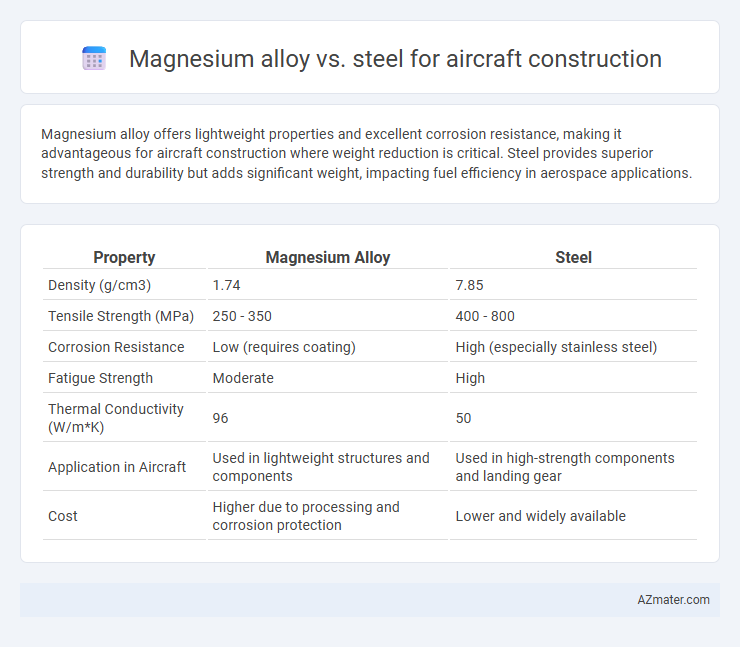Magnesium alloy offers lightweight properties and excellent corrosion resistance, making it advantageous for aircraft construction where weight reduction is critical. Steel provides superior strength and durability but adds significant weight, impacting fuel efficiency in aerospace applications.
Table of Comparison
| Property | Magnesium Alloy | Steel |
|---|---|---|
| Density (g/cm3) | 1.74 | 7.85 |
| Tensile Strength (MPa) | 250 - 350 | 400 - 800 |
| Corrosion Resistance | Low (requires coating) | High (especially stainless steel) |
| Fatigue Strength | Moderate | High |
| Thermal Conductivity (W/m*K) | 96 | 50 |
| Application in Aircraft | Used in lightweight structures and components | Used in high-strength components and landing gear |
| Cost | Higher due to processing and corrosion protection | Lower and widely available |
Introduction to Magnesium Alloys and Steel in Aircraft Construction
Magnesium alloys, known for their low density and high strength-to-weight ratio, offer significant advantages in reducing the overall weight of aircraft structures compared to traditional steel. Steel, widely used in aircraft construction for its superior tensile strength and durability, adds substantial weight but provides enhanced structural integrity and fatigue resistance. The choice between magnesium alloys and steel in aircraft manufacturing hinges on balancing weight reduction with mechanical performance and corrosion resistance.
Material Properties: Strength and Weight Comparison
Magnesium alloys offer significantly reduced weight compared to steel, with densities around 1.8 g/cm3 versus steel's approximately 7.8 g/cm3, making them ideal for weight-sensitive aircraft components. While steel exhibits higher tensile strength ranging from 400 to 2,000 MPa depending on the grade, magnesium alloys typically provide tensile strengths between 200 and 350 MPa, which can be enhanced with alloying and heat treatment. The strength-to-weight ratio of magnesium alloys often exceeds that of steel, enabling designers to optimize aircraft structures for both performance and fuel efficiency.
Corrosion Resistance: Durability in Aerospace Environments
Magnesium alloys offer lightweight advantages but exhibit lower corrosion resistance compared to steel in aerospace environments, necessitating advanced protective coatings or treatments to enhance durability. Steel, particularly stainless steel variants, provides superior corrosion resistance and structural integrity under harsh conditions, contributing to longer service life in aircraft construction. Effective corrosion management strategies are critical for both materials to ensure safety and longevity in aerospace applications.
Cost Analysis: Production and Maintenance
Magnesium alloy offers significant cost savings in aircraft production due to its lightweight properties, reducing fuel consumption and enabling lower manufacturing expenses compared to steel. Maintenance costs for magnesium alloys are generally higher because of increased susceptibility to corrosion and the need for specialized protective coatings, whereas steel provides greater durability and lower long-term maintenance expenses. Despite higher initial material costs, steel's robustness often results in a more economical lifecycle cost for aircraft structures.
Machinability and Fabrication Processes
Magnesium alloys offer superior machinability compared to steel, with lower cutting forces and reduced tool wear, making them ideal for intricate aircraft components requiring precision. Fabrication processes for magnesium alloys typically involve advanced casting and forging techniques tailored to their lightweight, corrosion-prone nature, while steel demands more robust welding and heat treatment protocols to ensure structural integrity. The choice between magnesium alloy and steel hinges on balancing machinability with fabrication complexity, weight reduction, and durability requirements in aerospace manufacturing.
Fatigue Performance and Structural Reliability
Magnesium alloys exhibit lower density than steel, resulting in significant weight savings crucial for aircraft construction, but their fatigue performance is generally inferior due to lower crack growth resistance and susceptibility to corrosion-induced damage. Steel offers superior fatigue strength and structural reliability, providing enhanced durability under cyclic loading and greater resistance to stress corrosion cracking, which is vital for maintaining aircraft integrity over prolonged service periods. Optimizing the trade-off between weight reduction and fatigue life requires advanced coatings or alloying techniques for magnesium alloys to improve their fatigue resistance without compromising structural safety.
Fire Safety: Flammability and Heat Tolerance
Magnesium alloys, while valued for their lightweight properties in aircraft construction, present significant fire safety challenges due to their high flammability and low ignition temperature, which can lead to intense combustion difficult to extinguish. Steel, in contrast, offers superior heat tolerance and fire resistance, maintaining structural integrity at elevated temperatures and reducing the risk of catastrophic failure during fire incidents. The choice between magnesium alloy and steel involves balancing weight reduction with enhanced fire safety measures to ensure compliance with aviation safety standards.
Environmental Impact and Sustainability
Magnesium alloys offer significant weight reduction compared to steel, leading to improved fuel efficiency and lower greenhouse gas emissions in aircraft operations. While magnesium extraction is energy-intensive, its recyclability and lighter weight contribute to overall sustainability by reducing the carbon footprint during the aircraft's lifecycle. Steel, though more energy-efficient to produce, results in heavier aircraft structures, increasing fuel consumption and associated environmental impacts over time.
Application Case Studies in Modern Aviation
Magnesium alloys, valued for their exceptional strength-to-weight ratio and corrosion resistance, are increasingly utilized in aircraft components such as seat frames, interior panels, and structural parts to reduce overall weight and enhance fuel efficiency. Steel, favored for its superior tensile strength and impact resistance, remains essential in critical load-bearing structures like landing gear, engine mounts, and fasteners where durability and safety are paramount. Case studies from manufacturers like Boeing and Airbus demonstrate strategic integration of magnesium alloys in non-critical areas, optimizing aircraft performance while maintaining steel's reliability in primary structural applications.
Future Trends in Aircraft Materials: Magnesium Alloy vs Steel
Magnesium alloys offer significant advantages in aircraft construction due to their low density and high strength-to-weight ratio, contributing to enhanced fuel efficiency and reduced emissions. Advances in corrosion resistance and alloy composition are expanding magnesium's viability as an alternative to traditional steel, which remains favored for its superior tensile strength and durability in critical structural components. Future trends indicate a hybrid use of magnesium alloys and high-strength steel composites, leveraging additive manufacturing and nano-engineering to optimize performance and sustainability in aerospace materials.

Infographic: Magnesium alloy vs Steel for Aircraft construction
 azmater.com
azmater.com